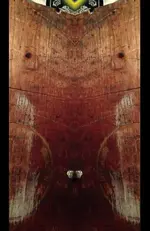Hey Trooper,
Without going into a crapton of boring details:
1. Yes, and most of what I have found is related to known trails of the time period I hunt. Take the fish monument on the previous page. It was originally mentioned in Chuck Kenworthy's Book "Spanish Monuments and Trailmarkers to Treasure in the United States". When Chuck passed away, I got a large box of his research stuff relating to Anza-Borrego Desert (and New Mexico). I have seen people that claim Kenworthy penciled in his pictures to make them more believable, or outright hoaxed them. Since I spent so much time out in ABDesert, I decided to hunt down some of Kenworthy's Monuments and see if they were different from the pics in his books. The monuments that I found in the desert are EXACTLY the same as the pictures in his books.
2. The greatest majority of the monuments I have found don't need too much of an imagination to see, for instance:

This is a Bird Monument. The bird means that you should go in the direction the bird is looking, but watch both sides of the trail, because a change of direction is coming shortly. In this case it was about a quarter mile.
3. Not seeing them makes it virtually impossible to tell why they were used in your area. With most monuments, the key thing to remember is the word "CONTEXT". Just like people can take things you say out of context, the same can be said for monuments. Just seeing a single monument/symbol/marker won't tell you a ton (except in some rare instances). If there is one monument, that means there are monuments before and after it.
Unfortunately, there are many people that see Spanish Monuments in bushes and everywhere else. While there are (my guess) tens of thousands of monuments in the Southwest US and Northern Mexico, 90% of them mainly deal with trails, campsites, and water sources. Here is a link to a thread I started about this subject a while back:
Monument Trail
Best of Luck - Mike
 Hello Nappy, love that spot, seen it before, is the bottom of the holes sand,dirt, or rock. If it has some fill,,remove it down to solid rock. How far back does the holes go,back? The( L),I have had a L, in the field, left from back line, you have two, the top L, is angled, so the backline is headed towards the hole, hard to explain. Focus there, never know till you dig. Goodluck, Thanks
Hello Nappy, love that spot, seen it before, is the bottom of the holes sand,dirt, or rock. If it has some fill,,remove it down to solid rock. How far back does the holes go,back? The( L),I have had a L, in the field, left from back line, you have two, the top L, is angled, so the backline is headed towards the hole, hard to explain. Focus there, never know till you dig. Goodluck, Thanks









